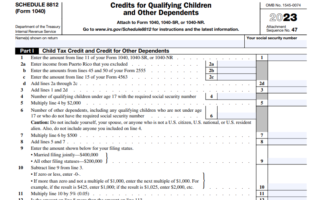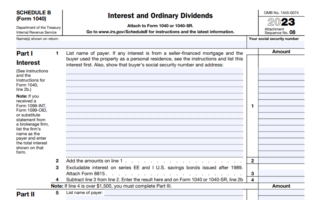Navigating the world of taxes can be complex, especially when it comes to understanding the nuances of self-employment tax. This comprehensive guide is designed to demystify IRS Schedule SE, an integral part of the tax Form 1040 for self-employed individuals. Understanding how to accurately file your taxes and Schedule SE is essential, whether you’re a freelancer, contractor, or run a small business. This article not only simplifies the process but also provides insights into optimizing your tax situation.
What Is Schedule SE from IRS?
Navigating the world of taxes can be complex, especially when it comes to understanding the nuances of self-employment tax. This comprehensive guide is designed to demystify IRS Schedule SE, an integral part of tax Form 1040 for self-employed individuals. Whether you’re a freelancer, contractor, or run a small business, understanding how to accurately file your taxes and Schedule SE is essential. This article not only simplifies the process but also provides insights into optimizing your tax situation.
Do You Need to File Schedule SE
The first step in understanding self-employment tax is recognizing when you need to file Schedule SE. This form is necessary for anyone who has earned $400 or more in self-employment income during the tax year. It’s used to calculate the amount of self-employment tax you owe, which includes both Social Security and Medicare taxes. It’s crucial to report your self-employment income accurately, as it forms the basis for the tax you owe. For those who have already paid social security tax through other employment, it’s important to note that there might be an impact on the amount subject to self-employment tax.
When completing Schedule SE, you’ll find that self-employment tax is a combination of two primary components: Social Security and Medicare taxes. The total tax rate is 15.3%, broken down into 12.4% for Social Security on the first $142,800 of your combined wages and net earnings in 2023, and 2.9% for Medicare on all your combined wages and net earnings. There is also an additional Medicare tax rate of 0.9% for those with incomes exceeding certain thresholds. Accurate reporting on Schedule SE is essential to ensure you’re paying the correct amount of tax and avoiding potential penalties.
Moreover, the amount of self-employment tax calculated on Schedule SE influences other parts of your individual income tax return. For instance, you can deduct half of your self-employment tax as a business expense, directly reducing your adjusted gross income. This deduction can be beneficial in lowering your overall tax liability. Also, if your total self-employment income is significant, you might need to make estimated tax payments throughout the year to avoid penalties for underpayment.
For those with more complex situations, such as income reported on Schedule K-1 of Form 1065, or for those who are not sure about their tax obligations, consulting a tax professional is advisable. They can provide personalized advice and help with calculating and reporting your self-employment tax, ensuring compliance with tax regulations.
Breaking Down Self-Employment Income
Comprehending the breadth of what constitutes self-employment income is fundamental to accurate tax reporting. This section delves into various income types that are considered self-employment, such as business profits, freelance earnings, and independent contractor payments. It explores how these diverse income streams are classified under tax law and how they influence your tax obligations. By dissecting the complex landscape of self-employment income, this part provides clarity, enabling self-employed individuals to better understand and meet their tax responsibilities.
Step-by-Step Guide to Filling Out Schedule SE
Navigating the complexities of Schedule SE can be daunting. This comprehensive guide meticulously breaks down each section of the tax form, offering step-by-step instructions to ensure precise and accurate reporting of self-employment tax form. From initial entries to the final calculations, this guide demystifies the process, providing clarity and confidence to taxpayers in fulfilling their obligations. This segment is designed not just to inform but to empower individuals in their journey through the nuances of tax filing.
Understanding the Role of IRS Forms 1040 and Schedule C
Forms 1040 and Schedule C are pivotal in the self-employment tax calculation process. This part elucidates how these forms interact with Schedule SE and their significance in accurately determining tax liabilities. It provides insights into the roles these forms play, highlighting their interconnectedness and importance in the broader context of tax filing. By understanding the functionalities and relationships of these forms, self-employed individuals can more effectively navigate the tax filing landscape.
Calculating Your Self-Employment Tax: A Detailed Approach
This segment offers an in-depth approach to calculating self-employment tax. It elucidates the specific tax rate applicable to self-employment and guides on applying this rate to your net earnings. By comprehending the intricacies of this calculation, including allowances and deductions, taxpayers can ensure they are meeting their tax obligations accurately. This detailed methodology aims to simplify what can often be a complex process, providing clarity and precision in tax calculations.
Social Security and Medicare Taxes: What Self-Employed Individuals Need to Know
This part delves into the specifics of the self-employment tax rate, breaking it down into its two essential components: Social Security Tax and Medicare Tax. It explains the significance of these contributions and how they accrue benefits for self-employed individuals in the long term. Understanding these components is crucial for recognizing the value of these taxes beyond their immediate financial impact, highlighting their role in ensuring long-term security and healthcare support.
The Self-Employment Tax Deduction: Maximizing Your Returns
One significant advantage of paying self-employment tax is the eligibility to deduct half of this amount on your income tax return. This section guides on how to claim this deduction, potentially reducing your overall tax liability. It explores the criteria and methods for claiming this deduction, making it a valuable resource for self-employed individuals looking to optimize their tax returns.
Avoiding Common Mistakes on Schedule SE
This segment addresses common errors encountered when filling out Schedule SE and strategies to avoid them. By highlighting typical pitfalls and providing practical advice, this part aims to streamline the tax filing process and prevent complications that could lead to penalties or audits. It serves as a precautionary guide, assisting taxpayers in maintaining accuracy and compliance.
Tools and Resources: Self-Employment Tax Calculator and Professional Advice
For those seeking additional support, this section introduces valuable tools like self-employment tax calculators and emphasizes the benefits of consulting a tax professional. It discusses how these resources can simplify the tax filing process and ensure adherence to regulations, providing peace of mind and reducing the likelihood of errors. This part is a gateway to a range of resources designed to assist in the efficient and accurate filing of taxes for self-employed individuals.
Key Takeaways
- Essential Understanding: Schedule SE is used to report and calculate self-employment tax for those with self-employment income.
- Filing Requirements: Know whether your self-employment income necessitates filing Schedule SE.
- Accurate Calculation: Learn to accurately calculate your self-employment tax based on your net earnings from self-employment.
- Tax Benefits: Understand the tax benefits, including the self-employment tax deduction.
- Avoiding Errors: Be aware of common mistakes and learn how to avoid them for hassle-free filing.
With a solid grasp of IRS Schedule SE and the self-employment tax process, you can confidently navigate your tax obligations, ensuring compliance and optimizing your tax benefits. This guide is your companion in mastering the intricacies of self-employment taxation.






